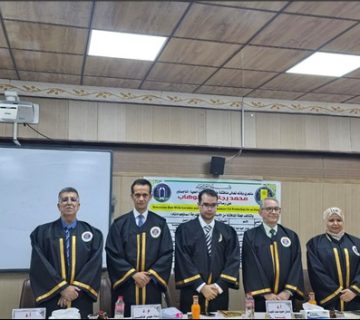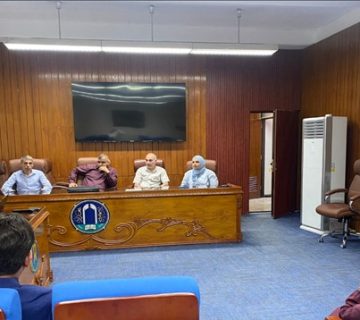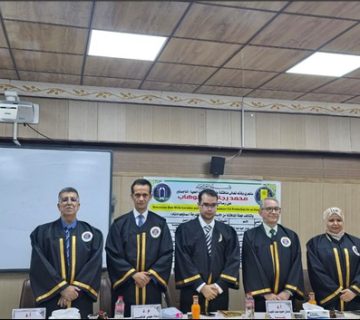The Chemical Engineering Department at the College of Engineering, University of Baghdad, held a Ph.D thesis examination titled:
“Preparation and Characterization of SAPO-34 by Microwave Irradiation for Production of Light Olefins from Alcohols“
By the student Mazin Jasim Mohammed and supervised by Prof. Dr. Najwa Saber Majeed. The examination committee consisted of Prof. Dr. Hussein Q. Hussein as Chairman and the membership of Prof. Dr. Asawer A. Alwasiti, Prof. Dr. Hayder A. Rasheid, Assist. Prof. Dr. Asrar Al-Obaidy, and Assist. Prof. Dr. Sarmad Al-Anssari. After conducting the public discussion and listening to the student’s defense, the thesis was accepted. The thesis was summarized as follows:
Ethylene, propylene and butylene as lower olefins are low molecular weight olefinic hydrocarbons which considered key materials for polymeric and petrochemical industries. Methanol-to-olefins (MTO) conversion over Silicoaluminophosphate-34 (SAPO-34) is an excellent and effective process for producing these olefins. For this purpose, it was tried to prepare SAPO-34 under microwave irradiation using diethylamine (DEA), triethylamine (TEA) and morpholine (MOR) as templates. SAPO-34 was prepared under constant microwave power of 800 W and crystallization time of 200 min. For its thermal stability and mild acidity, potassium (K) and silver (Ag) ions were incorporated by ion exchange method. Also, zirconium (Zr) metal was introduced by one-pot method. The catalyst samples were characterized by X-Ray Diffraction (XRD), Scanning Electron Microscopy (SEM), Energy-Dispersive X-Ray (EDX), Brunauer-Emmett-Teller (BET), Fourier Transforms Infrared (FTIR) and Thermogravimetric (TGA-DTG) techniques.
Using DEA and TEA templates failed to produce SAPO-34 and instead of it, SAPO-41 appeared. In contrast, SAPO-34 was successfully prepared using MOR template. The XRD analysis for SAPO-34, K-SAPO-34, Ag-SAPO-34 and ZrAPSO-34 exhibited typical SAPO-34 chabazite structure with high crystallinity. SEM-EDX analysis indicated to regular cubic shape of the catalysts. The surface area of SAPO-34/MOR, K-SAPO-34, Ag-SAPO-34 and ZrAPSO-34 samples was 194.59, 287.64, 254.63 and 77.57 m2/g, respectively. The vibration peaks of FTIR analysis for SAPO-34 and modified SAPO-34 were identical with SAPO-34 spectra bands. TGA analysis revealed very high stability against thermal cracking which the weight losses was less than 20% for all catalysts at high temperature reached to 1100 oC.
The catalytic performance towards MTO conversion was performed in trickle-bed reactor with wide range of temperature of 350, 400, 450 and 500 oC at weight hourly space velocity (WHSV) of 7.7 h-1. The conversion was almost 100% for all catalysts, especially at 400 and 450 oC. SAPO-34 recorded high olefin selectivity of about 63% with 100% conversion for 400 min at 400 oC. K-SAPO-34 showed higher olefins selectivity of about 85.1% at 450 oC with more than 400 min lifetime. Long lifetime was reported in methanol conversion over Ag-SAPO-34 of 475 min with 74% olefins selectivity at 450 oC. For, ZrAPSO-34, the experimental results showed that temperature of 400 oC revealed best olefin selectivity reached to 70% with longer catalyst lifespan of 500 min.
The effect of methanol concentration (30 wt% and 70 wt%) was also investigated over this catalyst. The results showed that 70 wt% water was more efficient. The effect of WHSV of 7.7, 15 and 21.1 h-1 on methanol conversion was also investigated over SAPO-34. It was found that increasing space velocity had a reverse effect on the conversion. Isopropanol as a feedstock was used instead of methanol. It was found that the conversion not exceed 90% for 200 min with low olefins selectivity of 43%.
The kinetics of MTO reaction over prepared SAPO-34s were investigated by conducting a set of experiments in the trickle bed reactor with space-time of 0.001, 0.003, 0.005 and 0.008 gcat gMeOH-1 h of 100% methanol. It was found that MTO reaction follows first-order kinetics of all used catalysts. The activation energy for catalysts SAPO-34, K-SAPO-34, Ag-SAPO-34 and ZrAPSO-34 was 17.38, 17.52, 17.65 and 17.19 kJ/mol, respectively.
A seven lumped mathematical model was formulated for MTO process for determining the kinetic parameters. gPROMS software has been used for modeling, simulation and estimating the parameters via optimization. The simulation results showed good consistency with experimental data or lumps with and absolute error less than 5%. Also, the software was used for modeling and simulating the regeneration process based on linear and nonlinear fittings depending on TGA analysis. The simulation results showed that the process obeys nonlinear regeneration fitting. The activation energy was 143.35, 127.19, 133.41 and 99.06 kJ/mol for SAPO-34, K-SAPO-34, Ag-SAPO-34 and ZrAPSO-34, respectively. Moreover, the catalysts lifetime was predicted using linear equation. The predicted lifespan during MTO reaction of catalysts SAPO-34, K-SAPO-34, Ag-SAPO-34 and ZrAPSO-34 was 508, 535, 524 and 631 min, respectively.








